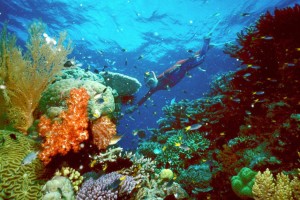
A tourist snorkels amid coral in the Great Barrier Reef. Photo credit: Great Barrier Reef Marine Park Authority.
In preparation for the thirty-seventh session of the UNESCO World Heritage Committee (WHC) in Phnom Penh their provisional agenda, State of conservation of World Heritage properties inscribed on the World Heritage List, has been released.
The agenda cites concerns about the significant loss of coral cover
over the past 27 years resulting mainly from storm damage, climate change effects and crown of thorns starfish and identify control of crown of thorn starfish outbreaks as important for restoring the loss.
Major concerns have been raised because no explicit policy statement by the Australian government assures port development outside of existing major port areas are not permitted. In Queensland 43 proposed developments are being assessed and in recent years a number of port boundaries were extended significantly to include areas of significant habitat that contribute to the reefs outstanding world heritage values. They note that the Queensland Deputy Premier’s media release announcing the draft Port Strategy stated that future development would be possible “at several locations such as Balaclava Island and Port Alma in the Port of Gladstone”. They also note that both these locations are outside existing major port areas (40 to 50 km away from the port of Gladstone), in the relatively undeveloped Fitzroy River delta, and that there is currently no development on Balaclava Island that could justify its classification as an
existing port area.
- the World Heritage Centre and IUCN received reports that the proposed changes to land use planning legislation would
significantly weaken protection of ecological features of the reef, including (riparian) vegetation in the property’s catchments; - require assessment of matters related to coastal protection for fewer types of development, and only for development proposals located in the narrow coastal management district; and
- weaken the provisions for dredging and disposal of dredged material.
All of which are part of the Queensland government's broad brush removal of environmental protection and regulation under the banner of 'green tape reduction'. Because of the lack of government progress the on several WHC recommendations and the absence of a commitment to address them they recommend that the Committee consider the Great Barrier Reef for inscription on the List of World Heritage in Danger in 2014.
Read the full UNESCO report here.
Sorry, the comment form is closed at this time.